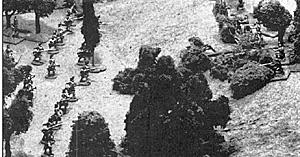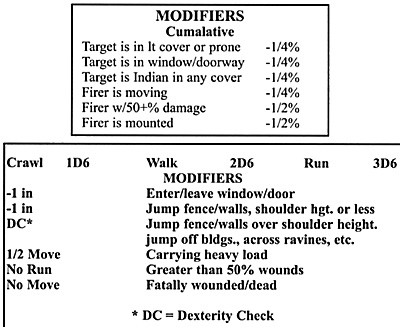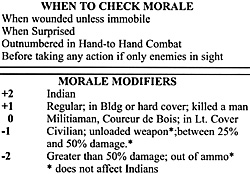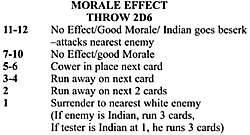I set about modifying Desperado to provide a period game that I could run at Tricon. After many playtests of scenarios taking place in up state New York, I ran several at the club, one at Tricon and several at HMGS conventions. Since everyone seemed to have a good time, I though it might be of interest to present the rules here for Desperado players or 18th century gamers who want to try something different. I am indebted to Tom Kelly who wrote the Desperado rules for his permission to present this here. Tom tells me that he got the idea for Desperado from an article that appeared in The Courier some time ago, "Two Gun Brown Comes To Town". To play this version, you will need a copy of the Desperado Rules, (Vol 1 & 2) which are available from Tom Kelly, 3625 Sundart Drive, Lexington KY 40512. They cost $14 + $2 shipping. The main difference between the 1870s plus of Desperado and the 1740s of the modified rules is in the ranges and the reload capability of the weaponry. Limiting a character to loading or firing makes for a lot fewer bleeding characters in the game - I have made up for this by modifying the hand-to-hand combat rules to allow for more complex (and more often) hand-to-hand combat. Further, as there was a mix of trained regulars, Indians, backwoodsmen and militia on both sides I introduced the concept of Volley Fire so as to give the regulars an advantage when they are able to get into a position to give volley fire. Another concept that I first came across in Mike Blake's Old West Rules, I believe, is that of the "invalid hit". Finally I added the concept that is used in many a wargame - so many that I can't imagine where I first saw it - the "Reaction Card". As mentioned above, you will need the rules for the basic concept of the rules, for the wound charts and explanations of the details. This is intended only as an addendum to thel rules. (Target goes prone - requires card to move) When the part of the body that would have been hit according to the chart is covered by a solid object so that the bullet could not have actually hit the target, the hit is called invalid, and pings off "into the brown" causing no further damage. The target then ducks down and will have to use a card to stand. (-10% penalty on shooting) When a character's card is drawn, rather than operating on it, he may retain it for use later in reaction to some action taken against him. He may use it to run into cover if someone is going to take a shot at him; he may use it to shoot at someone shooting at him (he and his antagonist dice to see who gets their shot off first if both loaded). As this "reaction" shot is a quick fire, 10% is subtracted from the % chance to hit. He may use it to fire on a target appearing in an area he is covering - a window, door, space between buildings or trees, etc. the -10% penalty still holds. He may use to run away from a melee after he has fought one round. No more than one card per character may be held. At the end of the turn, any cards that have not been used must be placed back in the deck. The reaction card may only be used in reaction to someone else's action. It cannot be used to initiate an action in lieu of, or in addition to your regular activation card unless so stated above. I find that this adds a lot of fun and uncertainty to the game and is essential with a lot of characters of various experience running through the deep woods of North America. Whenever a character tries do something that could result in a fall or a mishap (umpire should use his discretion here) he must roll a dexterity check. Simply he rolls 2 D10 and notes the number, he rolls the 2D10 again and must get equal of less than the first number rolled. If he fails then he rolls for damage location and damage points as in the rules. In one play of a scenario using the modified rules, Tom Desmond's Indian , Whatamug, wanted to jump over a close topped gorge that contained a fast flowing river. He diced a 99. Anything but 100 would see him safely across! Tom, of course, rolled the 100! The result – a drowned Indian. I felt that some characters, due to their life experience, should be able to get around better in the woods, thus the following Movement Rules. Movement is as per the rules, with the following exceptions: If moving off roads/paths/open spaces: (Regulars only)
It takes a little time and planning to from a volley line but the results can be well worth it if defending an open area or a bridge, ford, etc. An officer or, if they are all dead or incapacitated, a sergeant, can issue the Volley Fire order on his card. He may first move to meet the 4" requirement, but the figures participating in the Volley Fire must already be in position. If the officer/sergeant has a musket/rifle he can also participate in the Volley Fire. All figures using Volley Fire shoot together. The figures involved in the Volley Fire must be within 1 stand width of each other and within 4" of the officer/sergeant giving the "Volley Fire" order. The figures in the volley line all operate on the officer's/sergeant's card and ignore their own. If any figure has to use a reaction card to react to melee (i.e. he had it before the volley line was formed), etc the Volley Fire sequence is broken and must start over. Otherwise the men of the Volley line must be released from it by an officer/sergeant. If all officers/sergeants are dead or incapacitated, members of the volley line follow their own card beginning the next turn. Obviously to fire, they must already be loaded, though the officer/sergeant could give a load order on his card, then a fire order on his next card.
The "Beaten Zone" of the Volley Fire is an area whose length is the range of the majority of the weapons in the firing line and width is the frontage of the firing line +300 to either side. See Diagram. Effect: Add 5% times the number of men firing (but not to exceed 20%) to the basic chance of a hit calculated in the usual way (taking into account range, cover, wounds of the firer, etc). Consider the effect on the closest target first, then the next closest, etc. until the maximum number of targets has been hit (equal to the number of men firing).
Movement is as per the rules except that One cannot load a weapon while moving faster than a walk or while lying prone unless he is a backwoodsman\coureur -de-bois. Once cannot load a rifle or a musket while on horseback. Bows do not have to be loaded between shots. One thing that I didn't like about Desperado was the hand–to-hand combat rules. They are too simplistic – I know that the author laudable goal is to maintain simplicity, but he went a little far in this area. Whether you have a bayonet on a rifle against someone who has only his bare hands, the chances of overpowering your opponent is the same. For a period where the characters would carry anything from swords and bayonets to tomahawks and bows, a more detailed set of combat rules was required. Hand-To-Hand combat takes place on a card when two men are within 1" of each other and one (or both) wants to fight. The first round of combat is calculated on the first card of contact and continues until one or both are down or one runs away or surrenders on his card. The HTH rules are based on a comparison of the weapons used. Both participants take the basic chance of 50% and add it to the factor for his weapon type and then subracts the opponent weapon factor for a basic CHANCE-TO-HIT. He then adds modifiers based on the situation. Both participants then roll 2D10, if either roll a number equal to or less than his MODIFIED CHANCE TO HIT, wound location and severity are diced for as per the rules. If both hit, it is considered that the attack was parried, the participants are locked in battle and will dice again when either participant's card comes up. If additional parties are added to the melee, set up the opposing pairs, left over figures "gang up' on one of the opponents. Each pair-off is rolled as a separate melee, an outnumbered character, strangely enough, counting as "outnumbered", checks his morale and if good stays in the melee. EXAMPLE: Characters A and B attack Character X.X checks morale for being outnumbered in melee and stands. The melees are A vs X and B vs X. If a character Z is added to the melee on X's side, the melees are A vs X(or Z) and B vs Z or X. Characters locked in melee can run away on their next card or on a REACTION CARD.but takes a "free hit' from his opponent(s).
The other area that I believe that the author carried his quest for simplicity beyond the pale was in morale. One could be way ahead in the game, be called out by a near-dead opponent and loose on dice. A more detailed Morale rule was required.
Charts
 A couple of years ago I wanted to support a local convention, Tricon with some games. Tricon, however, was an exclusively 18th century convention held in Concord MA and I didn't game in that period - or while I gamed in other people's games of the period I didn't have figures nor rule knowledge of the period sufficient to put on a convention game. I had been playing a lot of Desperado games, however, they are a great change of pace at the club and my 6 year old grandson was so stricken by them that I played him 4-6 scenarios a week!
A couple of years ago I wanted to support a local convention, Tricon with some games. Tricon, however, was an exclusively 18th century convention held in Concord MA and I didn't game in that period - or while I gamed in other people's games of the period I didn't have figures nor rule knowledge of the period sufficient to put on a convention game. I had been playing a lot of Desperado games, however, they are a great change of pace at the club and my 6 year old grandson was so stricken by them that I played him 4-6 scenarios a week!THE INVALID HIT
THE REACTION CARD
THE DEXTERITY CHECK
MOVEMENT
VOLLEY FIRE
 Each target in the "Beaten Zone" may have his own characteristics due to distance, cover, etc. The maximum number of targets that can be hit is the number of weapons firing.
Each target in the "Beaten Zone" may have his own characteristics due to distance, cover, etc. The maximum number of targets that can be hit is the number of weapons firing.SPECIAL RULES FOR WEAPON LOADING
HAND TO HAND COMBAT
MORALE





Desperado Scenario: Action on the Overkill
Back to Table of Contents -- Courier #75
To Courier List of Issues
To MagWeb Master Magazine List
© Copyright 1998 by The Courier Publishing Company.
This article appears in MagWeb (Magazine Web) on the Internet World Wide Web.
Other military history articles and gaming articles are available at http://www.magweb.com